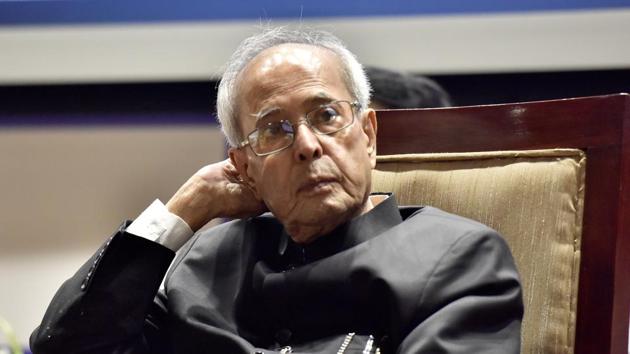Emergency, Sanjay Gandhi: As Pranab Mukherjee receives Bharat Ratna, a look at his memoirs
The former president’s political career began in 1969 and there was no looking back after that. He has been a member of both Lok Sabha and Rajya Sabha and has held top posts of Defence Minister, Finance Minister, External Affairs Minister, Leader of Lok Sabha, Leader of Rajya Sabha and the President of India.
Former President Pranab Mukherjee, 83, will receive India’s highest civilian award Bharat Ratna today, a recognition of his more than four-decade long political life during which he served the country in various capacities.

The former president’s political career began in 1969 and there was no looking back after that. He has been a member of both Lok Sabha and Rajya Sabha and has held top posts of Defence Minister, Finance Minister, External Affairs Minister, Leader of Lok Sabha, Leader of Rajya Sabha and the President of India.
Pranab Mukherjee has meticulously captured his political career in his three books published between 2014 and 2017 -- The coalition years (2017), The Turbulent years (2016), The Dramatic decade (2014).
Here are a few excerpts from his memoirs that capture the essence of his political career and the circumstances that led to key events:
‘The Coalition Years: 1996-2012’
In this autobiography, the third of the series, Mukherjee made no bones of his ambitions and said he had a “vague impression” that Congress may project Manmohan Singh as its presidential candidate, leaving him to be the party’s prime ministerial nominee for the 2014 general election. Excerpt:
I thought that if she (Sonia Gandhi) selected (Manmohan) Singh for the presidential office, she may choose me as the prime minister. I had heard a rumour that she had given this formulation a serious thought while on a holiday in the Kaushambi Hills.
The fact was that I was reluctant to join the government (led by Manmohan Singh) and informed Sonia Gandhi accordingly. She, however, insisted that I should join the government since I would be vital to its functioning...
The Turbulent Years: 1980-1996
On Sanjay Gandhi
In the second part of his memoir, Mukherjee heaped praises on late Congress leader Sanjay Gandhi.Mukherjee called the Congress leader the principal architect, along with his mother, of the party’s victory in 1980 general elections. Excerpt:
Sanjay Gandhi had played a crucial role in the elections. He had planned as well as executed a nationwide campaign and he worked hard to ensure the success of the party in the assembly elections. He revamped the organizational machinery in the states and, post the elections, hand-picked new chief ministers --- ensuring that those who had stood by Mrs Gandhi during her days of crisis were suitably rewarded...
In much of post-Emergency literature, Sanjay Gandhi has been characterised as a villain, devoid of any good qualities. This animosity and venom against him was to a large extent the result of the euphoria surrounding the Janata Party’s creation, a wave of anti-Mrs (Indira) Gandhi sentiment and the division in the Congress.
Every human being is a mixture of good and bad. However, no one can fault the intentions guiding Sanjay’s decisions --- whether these pertained to population control, tackling illiteracy or afforestation. His ideas were good, and all targeted at bringing about positive change. And, as someone who knew him well and worked with him for six years of his political life, I was privy to many of his positive virtues.
On Operation Bluestar
The former president shared an insider’s account of several significant events during the 1980’s and early 1990’s. Mukherjee, then a cabinet minister in the Indira Gandhi government, justified the 1984 military action to flush out terrorists from the Golden Temple in Amritsar. Excerpt:
I still vividly recall Mrs Gandhi telling me, ‘Pranab, I know of the consequences.’ She understood the situation well and was clear that there was no other option. Aware that her own life was at risk, she took a conscious decision to go ahead in the best interest of the nation.”
It is easy to say that the military action could have been avoided. However, nobody really knows if any other option would have worked. Such decisions are always taken based on the conditions prevailing at that time. The situation in Punjab was abnormal. Urgent action was needed to put an end to the indiscriminate killings, the misuse of religious sites for terrorist activities and all efforts to break up the Indian union. Intelligence officials and the army both expressed confidence that they would be able to neutralize the militants in the Golden Temple complex without much difficulty. No one anticipated the protracted resistance.
Dramatic Decade: The Indira Gandhi Years
On Emergency
In The Dramatic Decade: The Indira Gandhi Years, Pranab Mukherjee described the Emergency years, during which fundamental rights were suspended, press was censored and political dissidents were arrested, as a “misadventure” . Excerpt:
While there is no doubt that it brought with it some major positive changes…it was perhaps an avoidable event... some instances of the Emergency adversely affecting the interests of the people.
The Congress and Indira Gandhi had to pay a heavy price for this misadventure.






